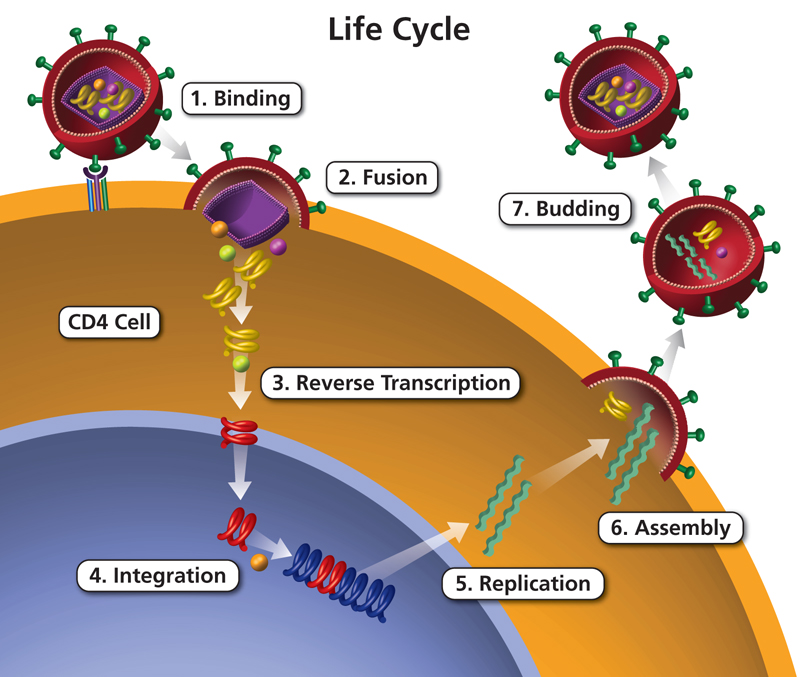HIV (human immunodeficiency virus) is an infection that affects approximately 1.2 million people in the United States. The infection is very difficult to treat because the virus combines its genetic information with the genetic information of a type of white blood cell called CD4 cells. HIV can continue to replicate without treatment, generating more than 10 billion new viral particles per day.
HIV has three main stages:
- Acute HIV. A large amount of HIV is present in your blood. Some people develop flu-like symptoms, such as chills, fever, and sore throat. It occurs about 2 to 4 weeks after exposure.
- Chronic HIV. Once the acute symptoms subside, you enter the chronic stage where HIV replicates at low levels. You are still contagious at this stage, but you may not have symptoms.
- AIDS. AIDS is the last stage of HIV and severely affects your immune system. It is characterized by a CD4 count of fewer than 200 cells per cubic millimetre of blood.
The replication cycle, or life cycle, of HIV, can be divided into seven stages. Medicines that treat HIV interrupt one of the seven stages of the HIV infection cycle. In an actively infected cell, the entire life cycle lasts only 1 or 2 days. But some cells can be latently infected, meaning that HIV can potentially be present in them for years without producing new virus particles. At any time, these cells can become activated and start producing viruses.
1. Binding
HIV belongs to a group of viruses called retroviruses. These viruses are difficult to get rid of because they integrate with the host cell’s DNA as part of their life cycle. During the first stage of the HIV life cycle, the virus binds to receptors on the surface of CD4 cells. CD4 cells, also called helper T cells, are a type of white blood cell that alert other immune cells that there is an infection in your body.

2. Fusion
HIV is an enveloped virus, which means that its genetic information is protected by both a protein layer and a lipid layer called the envelope. Once HIV binds to receptors on CD4 cells, it initiates the fusion of its envelope with the CD4 cell membrane using a glycoprotein called GP120. Glycoproteins are molecules made up of carbohydrate and protein chains. Fusion with the membrane of your CD4 cells allows the virus to enter the cell.
3. Reverse transcription
Reverse transcription is a process of converting genetic information in the form of RNA into DNA. RNA and DNA contain similar genetic information but are structurally different. RNA is usually made up of a long strand of genetic information, while DNA is made up of a double strand. The virus converts its RNA into DNA by releasing an enzyme called reverse transcriptase. This process allows the genetic information of the virus to enter the nucleus of your CD4 cell.
4. Integration
Once HIV has converted its RNA to DNA, it releases another enzyme called integrase into the nucleus of your CD4 cell. The virus uses this enzyme to combine its DNA into the DNA of your CD4 cell. At this point, the infection is still considered latent and is difficult to detect even with sensitive laboratory tests.
5. Replication
Because HIV is now embedded in the DNA of your CD4 cells, it can use that cell’s machinery to make viral proteins. During this time, it can also make more of its genetic material (RNA). These two things allow you to create more viral particles.
6. Assembly
In the assembly stage, new HIV proteins and RNA are delivered to the edge of the CD4 cell and become immature HIV. These viruses are not infectious in their current form.
7. Budding
During the budding stage, immature viruses break out of their CD4 cell. They then release an enzyme called protease that modifies the proteins of the virus and creates a mature, infectious version.

